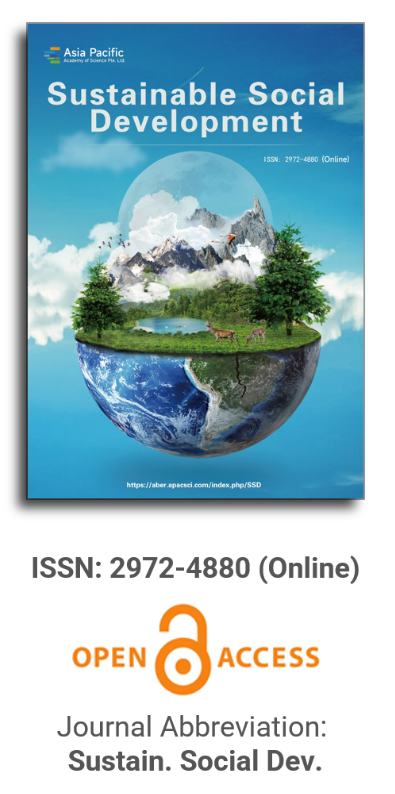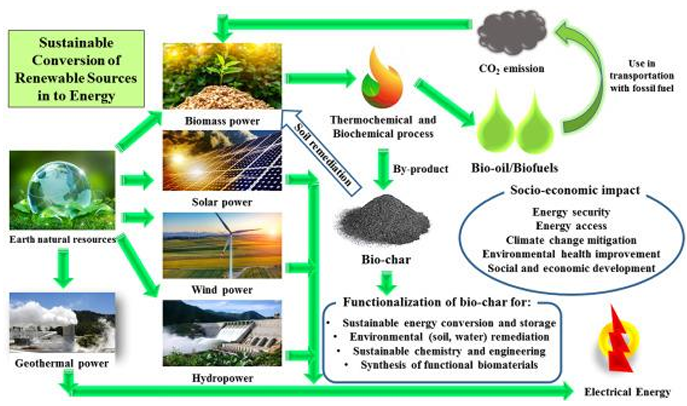
Asia Pacific Academy of Science Pte. Ltd. (APACSCI) specializes in international journal publishing. APACSCI adopts the open access publishing model and provides an important communication bridge for academic groups whose interest fields include engineering, technology, medicine, computer, mathematics, agriculture and forestry, and environment.

Anthropocene futures: Regeneration as a decarbonization strategy
Vol 3, Issue 1, 2025
Download PDF
Abstract
In the context of the Anthropocene, and in the face of an unprecedented climate crisis generating 20 billion tonnes of CO2 annually, this study critically examines the transition from a ‘grey’ economy based on fossil fuels to a ‘green’ and regenerative economy, proposing two interrelated strategies: the transformation of terrestrial and agricultural systems to enhance natural carbon sequestration (including halting deforestation, regenerative agriculture and sustainable livestock systems), and the restructuring of global social metabolism (promoting reduced consumption, circular economies and renewable energy). The analysis emphasizes that this transition will require unprecedented global cooperation and bold government policies and will face significant challenges such as resistance from entrenched interests and global inequalities; however, the expected benefits—including a stable climate, healthy ecosystems and a sustainable economy—justify the necessary efforts, framing this transformation not just as a technical challenge but as an ethical and ontological imperative to move from an extractive relationship with the planet to a co-creative role that ensures intergenerational prosperity and planetary health.
Keywords
References
- Malhi Y. The Concept of the Anthropocene. Annual Review of Environment and Resources. 2017; 42(1): 77-104. doi: 10.1146/annurev-environ-102016-060854
- Steffen W, Crutzen P, McNeill J. The anthropocene: are humans now overwhelming the great forces of nature. Ambio. 2007; 36 (8): 614-621. doi: 10.1579/0044-7447
- Castree N. The Anthropocene and the Environmental Humanities: Extending the Conversation. Environmental Humanities. 2014; 5(1): 233-260. doi: 10.1215/22011919-3615496
- Zalasiewicz J, Williams M, Haywood A, et al. The Anthropocene: a new epoch of geological time?. Philosophical Transactions of the Royal Society A: Mathematical, Physical and Engineering Sciences. 2011; 369(1938): 835-841. doi: 10.1098/rsta.2010.0339
- Ehrlich PR, Ehrlich AH. Can a collapse of global civilization be avoided?. In: Proceedings of the Royal Society B: Biological Sciences. 2013; 280(1754): 20122845. doi: 10.1098/rspb.2012.2845
- Grumbach S, Hamant O. Digital revolution or anthropocenic feedback?. The Anthropocene Review. 2017; 5(1): 87-96. doi: 10.1177/2053019617748337
- Lade SJ, Steffen W, de Vries W, et al. Human impacts on planetary boundaries amplified by Earth system interactions. Nature Sustainability. 2019; 3(2): 119-128. doi: 10.1038/s41893-019-0454-4
- Anttiroiko AV. Castells’ network concept and its connections to social, economic and political network analyses. Journal of Social Structure. 2015; 16(1): 1-18. doi: 10.21307/joss-2019-021
- Surugiu MR, Surugiu C. International trade, globalization and economic interdependence between European countries: implications for businesses and marketing framework. Procedia Economic and Finance. 2015; 32: 131-138. doi: 10.1016/S2212-5671(15)01374-X
- Herrfahrdt-Pähle E, Schlüter M, Olsson P, et al. Sustainability transformations: socio-political shocks as opportunities for governance transitions. Global Environmental Change. 2020; 63: 102097. doi: 10.1016/j.gloenvcha.2020.102097
- Görg C, Plank C, Wiedenhofer D, et al. Scrutinizing the Great Acceleration: The Anthropocene and its analytic challenges for social-ecological transformations. The Anthropocene Review. 2019; 7(1): 42-61. doi: 10.1177/2053019619895034
- Ceballos G, García A, Ehrlich P. The sixth extinction crisis loss of animal populations and species. Journal of Cosmology. 2010.
- Martin JL, Maris V, Simberloff DS. The need to respect nature and its limits challenges society and conservation science. In: Proceedings of the National Academy of Sciences. 2016; 113(22): 6105-6112. doi: 10.1073/pnas.1525003113
- Michel SE, Lan X, Miller J, et al. Rapid shift in methane carbon isotopes suggests microbial emissions drove record high atmospheric methane growth in 2020–2022. In: Proceedings of the National Academy of Sciences. 2024; 121(44). doi: 10.1073/pnas.2411212121
- Collins A, Galli A, Hipwood T, et al. Living within a One Planet reality: the contribution of personal Footprint calculators. Environmental Research Letters. 2020; 15(2): 025008. doi: 10.1088/1748-9326/ab5f96
- Pavone IR. The Paris Agreement and the Trump administration: Road to nowhere? Journal of International Studies. 2018; 11(1): 34-49. doi: 10.14254/2071-8330.2018/11-1/3
- Lashitew A, Mu Y. Corporate opposition to climate change disclosure regulation in the United States. Climate Policy. Published online August 27, 2024: 1-16. doi: 10.1080/14693062.2024.2394518
- Kedia S. Approaches to low carbon development in China and India. Advances in Climate Change Research. 2016; 7(4): 213-221. doi: 10.1016/j.accre.2016.11.001
- Zhang Z. Making the Transition to a Low‐Carbon Economy: The Key Challenges for China. Asia & the Pacific Policy Studies. 2016; 3(2): 187-202. doi: 10.1002/app5.138
- Ho DT, Lamers P, Nawaz S, et al. Navigating the obstacles of carbon-negative technologies. One Earth. 2024; 7(9): 1471-1476. doi: 10.1016/j.oneear.2024.08.016
- Walls JL, Vogel LL. Regenerative economy: A pathway to a future-ready, sustainable Africa. Africa Journal of Management. 2023; 9(4): 315-337. doi: 10.1080/23322373.2023.2275110
- Tàbara JD. Regenerative sustainability. A relational model of possibilities for the emergence of positive tipping points. Environmental Sociology. 2023; 9(4): 366-385. doi: 10.1080/23251042.2023.2239538
- West S, Haider LJ, Hertz T, et al. Relational approaches to sustainability transformations: walking together in a world of many worlds. Ecosystems and People. 2024; 20(1). doi: 10.1080/26395916.2024.2370539
- Gusenbauer M, Gauster SP. How to search for literature in systematic reviews and meta-analyses: A comprehensive step-by-step guide. Technological Forecasting and Social Change. 2025; 212: 123833. doi: 10.1016/j.techfore.2024.123833
- Moore A. Anthropocene anthropology: reconceptualizing contemporary global change. Journal of the Royal Anthropological Institute. 2015; 22(1): 27-46. doi: 10.1111/1467-9655.12332
- Crutzen P. Earth System Science in the Anthropocene. Berlin, Heidelberg: Springer; 2006.
- Velders GJM, Andersen SO, Daniel JS, et al. The importance of the Montreal Protocol in protecting climate. Proceedings of the National Academy of Sciences. 2007; 104(12): 4814-4819. doi: 10.1073/pnas.0610328104
- Pineda Pinto M, Steele W. Regenerative Urban Development Paradigms in a Time of Climate Change and Ecological Crisis. In: Future Cities Making. Theory and Practice of Urban Sustainability Transitions. Singapore: Springer; 2025.
- Otto IM, Wiedermann M, Cremades R, et al. Human agency in the Anthropocene. Ecological Economics. 2020; 167: 106463. doi: 10.1016/j.ecolecon.2019.106463
- Taveras-Dalmau V. It’s getting personal: exploring our inner world in the regenerative paradigm shift. Tourism Geographies; 2024.
- Svarstad H, Benjaminsen TA. Political ecology and the power of sociology. Elgar Encyclopedia of Environmental Sociology; 2024.
- Wackernagel M. Ecological Footprint6. Elgar Encyclopedia of Environmental Sociology; 2024.
- Toledo VM. Social metabolism: a new socioecological theory (Spanish). Relaciones Estudios de Historia y Sociedad. 2013; 34(136): 41-71. doi: 10.24901/rehs.v34i136.163
- Auerbach D, Clark B, Adua L. Jevons paradox. Elgar Encyclopedia of Environmental Sociology; 2024.
- Lewis SL, Maslin MA. Defining the Anthropocene. Nature. 2015; 519(7542): 171-180. doi: 10.1038/nature14258
- Gillings MR, Paulsen IT. Microbiology of the Anthropocene. Anthropocene. 2014; 5: 1-8. doi: 10.1016/j.ancene.2014.06.004
- Brondizio ES, O’Brien K, Bai X, et al. Re-conceptualizing the Anthropocene: A call for collaboration. Global Environmental Change. 2016; 39: 318-327. doi: 10.1016/j.gloenvcha.2016.02.006
- Informe GEO5. The Global Environment Outlook: Environment for the future we want (GEO-5). Nairobi: UNEP; 2012.
- Cowgill U. Acid precipitation: a review. Studies in Environmental Science. 1984; 25: 233-259. doi: 10.1016/S0166-1116(08)72112-5
- Konikow LF, Kendy E. Groundwater depletion: A global problem. Hydrogeology Journal. 2005; 13(1): 317-320. doi: 10.1007/s10040-004-0411-8
- Hmiel B, Petrenko VV, Dyonisius MN, et al. Preindustrial 14CH4 indicates greater anthropogenic fossil CH4 emissions. Nature. 2020; 578(7795): 409-412. doi: 10.1038/s41586-020-1991-8
- Turetsky MR, Abbott BW, Jones MC, et al. Permafrost collapse is accelerating carbon release. Nature. 2019; 569(7754): 32-34. doi: 10.1038/d41586-019-01313-4
- Kassas M. The biosphere and the threat of global industrialization: Limits of the biosphere. The Environmentalist. 1989; 9(4): 261-268. doi: 10.1007/bf02241826
- Qing QL, Loganath A, Seng Chong Y, et al. Persistent Organic Pollutants and Adverse Health Effects in Humans. Journal of Toxicology and Environmental Health, Part A. 2006; 69(21): 1987-2005. doi: 10.1080/15287390600751447
- Yuewen D, Adzigbli L. Assessing the Impact of Oil Spills on Marine Organisms. Journal of Oceanography and Marine Research. 2018; 06(01). doi: 10.4172/2572-3103.1000179
- Duguma LA, Atela J, Minang PA, et al. Deforestation and Forest Degradation as an Environmental Behavior: Unpacking Realities Shaping Community Actions. Land. 2019; 8(2): 26. doi: 10.3390/land8020026
- Carvalho FP. Pesticides, environment, and food safety. Food and Energy Security. 2017; 6(2): 48-60. doi: 10.1002/fes3.108
- Baisero D, Visconti P, Pacifici M, et al. Projected Global Loss of Mammal Habitat Due to Land-Use and Climate Change. One Earth. 2020; 2(6): 578-585. doi: 10.1016/j.oneear.2020.05.015
- Reyes-García V, Guèze M, Luz AC, et al. Evidence of traditional knowledge loss among a contemporary indigenous society. Evolution and Human Behavior. 2013; 34(4): 249-257. doi: 10.1016/j.evolhumbehav.2013.03.002
- Hrubec M, Uhde Z. Global Conflicts and Local Interactions: Contradictions of Global Capitalism and Civil Society. Critical Sociology. 2018; 45(6): 777-783. doi: 10.1177/0896920518798880
- Martins F, Felgueiras C, Smitkova M, et al. Analysis of Fossil Fuel Energy Consumption and Environmental Impacts in European Countries. Energies. 2019; 12(6): 964. doi: 10.3390/en12060964
- Lambin EF, Geist HJ, Lepers E. Dynamics of Land-Use and Land-Cover Change in Tropical Regions. Annual Review of Environment and Resources. 2003; 28(1): 205-241. doi: 10.1146/annurev.energy.28.050302.105459
- Babic M. Let’s talk about the interregnum: Gramsci and the crisis of the liberal world order. International Affairs. 2020; 96(3): 767-786. doi: 10.1093/ia/iiz254
- Bai X, van der Leeuw S, O’Brien K, et al. Plausible and desirable futures in the Anthropocene: A new research agenda. Global Environmental Change. 2016; 39: 351-362. doi: 10.1016/j.gloenvcha.2015.09.017
- Bonneuil C. The geological turn: narratives of the Anthropocene. In: The Anthropocene and the Global Environmental Crisis: Rethinking modernity in a new epoch. Routledge; 2015.
- Descola P. Beyond nature and culture. HAU: Journal of Ethnographic Theory. 2012; 2(1): 447-471. doi: 10.14318/hau2.1.020
- Latour B. Telling friends from foes in the time of the Anthropocene. In: The Anthropocene and the Global Environmental Crisis: Rethinking modernity in a new epoch. Routledge; 2015.
- Diamond J. Collapse: How Societies Choose to Fail or Succeed. New York: Viking Penguin; 2005.
- Tainter JA. Archaeology of Overshoot and Collapse. Annual Review of Anthropology. 2006; 35(1): 59-74. doi: 10.1146/annurev.anthro.35.081705.123136
- Hornborg A, McNeill J, Martinez-Alier J. Rethinking Environmental History: World-System History and Global Environmental Change. Lanham: Altamira Press; 2007.
- González de Molina M, Toledo VM. Social Metabolism: Origins, History, Approaches, and Main Schools. In: The Social Metabolism. Environmental History, Springer, Cham; 2023.
- Danowski D, Viveiros de Castro E. Fears and the ends... of the world (Spanish). Revista Nueva Sociedad; 2019.
- Meadows DH, Randers J, Meadows DL. The Limits to Growth. New York: Universe Books; 1972.
- Watson A, Gingrich S, MacFadyen J. Recent advances in social metabolism research: Sources and methods. Historical Methods. A Journal of Quantitative and Interdisciplinary History. 2024; 57(4): 199–204. doi: 10.1080/01615440.2024.2441076
- Hao P, Wu X, Liu Z, et al. Integrating traditional and biotechnological innovations for mitigating greenhouse gas emissions in dairy farming in China. Journal of Cleaner Production. 2025; 486: 144457. doi: 10.1016/j.jclepro.2024.144457
- Irfan F, Tasnim N, Razzak SA, et al. Advances in capturing carbon and producing bioplastics through the microalgal approach towards a sustainable future: A review. Journal of Cleaner Production. 2025; 486: 144576. doi: 10.1016/j.jclepro.2024.144576
- Muñoz C, Muñoz IA, Rodríguez R, et al. Effect of combining the methanogenesis inhibitor 3-nitrooxypropanol and cottonseeds on methane emissions, feed intake, and milk production of grazing dairy cows. animal. 2024; 18(7): 101203. doi: 10.1016/j.animal.2024.101203
- El-Moustaqim K, Sbai SE, El Yousfi Y, et al. New strategy for the advancement of modern agriculture through the use of microalgae as biofertilizers. Euro-Mediterranean Journal for Environmental Integration. 2024.
- Grossule V, Henjak M, Beggio G, et al. Biowaste treatment using black soldier fly larvae: Effect of substrate macronutrients on process performance. Journal of Environmental Management. 2025; 373: 123605. doi: 10.1016/j.jenvman.2024.123605
- NOAA. Earth System Research Laboratory: Trends in Atmospheric Carbon Dioxide. Available online: https://www.esrl.noaa.gov/gmd/ccgg/trends/gl_trend.html (access on 6 January 2025).
- Keller DP, Lenton A, Littleton EW, et al. The Effects of Carbon Dioxide Removal on the Carbon Cycle. Current Climate Change Reports. 2018; 4(3): 250-265. doi: 10.1007/s40641-018-0104-3
- IPCC. The Physical Science Basis’ Contribution of Working Group I to the Fourth Assessment Report of the Intergovernmental Panel on Climate Change. Available online: https://www.ipcc.ch/site/assets/uploads/2018/05/ar4_wg1_full_report-1.pdf (access on 10 September 2024).
- Hsieh YL, Yeh SC. The trends of major issues connecting climate change and the sustainable development goals. Discover Sustainability. 2024; 5(1). doi: 10.1007/s43621-024-00183-9
- Tortell PD. Earth 2020: Science, society, and sustainability in the Anthropocene. In: Proceedings of the National Academy of Sciences. 2020; 117(16): 8683-8691. doi: 10.1073/pnas.2001919117
- Molina MJ, Rowland FS. Stratospheric sink for chlorofluoromethanes: chlorine atom-catalysed destruction of ozone. Nature. 1974; 249(5460): 810-812. doi: 10.1038/249810a0
- Kannan K, Tanabe S, Giesy J et al. Organochlorine pesticides and polychlorinated biphenyls in foodstuffs from Asian and oceanic countries. Reviews of Environmental Contamination and Toxicology; 1997.
- Steinbacher M, Vollmer MK, Buchmann B, et al. An evaluation of the current radiative forcing benefit of the Montreal Protocol at the high-Alpine site Jungfraujoch. Science of The Total Environment. 2008; 391(2-3): 217-223. doi: 10.1016/j.scitotenv.2007.10.003
- Kanter D, Mauzerall DL, Ravishankara AR, et al. A post-Kyoto partner: Considering the stratospheric ozone regime as a tool to manage nitrous oxide. In: Proceedings of the National Academy of Sciences. 2013; 110(12): 4451-4457. doi: 10.1073/pnas.1222231110
- Ghani G. The Montreal Protocol: Developing Countries Import of Halons. Economics Bulletin; 2007.
- Ivanova K. Corruption, illegal trade and compliance with the Montreal Protocol. Environmental and Resource Economics. 2007; 38(4): 475-496. doi: 10.1007/s10640-007-9088-5
- Stone CD. Common But Differentiated Responsibilities in International Law. American Journal of International Law. 2004; 98(2): 276-301. doi: 10.2307/3176729
- Jotzo F. Developing countries and the future of the kyoto protocol. Global Change, Peace & Security. 2005; 17(1): 77-86. doi: 10.1080/0951274052000319373
- Mor S, Aneja R, Madan S, et al. Kyoto Protocol and Paris Agreement: Transition from Bindings to Pledges—A Review. Millennial Asia. 2023; 15(4): 690-711. doi: 10.1177/09763996221141546
- Bodansky D. The UN Climate Change Regime Thirty Years on: A Retrospective and Assessment+. Environmental Policy and Law. 2023; 53(1): 19-33. doi: 10.3233/epl-219047
- Depledge J. The future of negotiations under the climate change COP (Conference of the Parties): Implementation is not enough. Dialogues on Climate Change. 2024; 1(1): 12-17. doi: 10.1177/29768659241293212
- Desai BH, Desai JB. The Climate Change Conundrum: A Case for Course Correction in the Global Regulatory Approach$. Environmental Policy and Law. 2024; 54(1): 3-14. doi: 10.3233/epl-239028
- Clémençon R. 30 Years of International Climate Negotiations: Are They Still our Best Hope? The Journal of Environment & Development. 2023; 32(2): 114-146. doi: 10.1177/10704965231163908
- Sahu R, Kumar P. The Missing Nexus: A Historical and Contemporary Position of the United States on Climate Change Action. International Studies. 2023; 60(4): 444-479. doi: 10.1177/00208817231204663
- Keenan TF, Prentice IC, Canadell JG, et al. Recent pause in the growth rate of atmospheric CO2 due to enhanced terrestrial carbon uptake. Nature Communications. 2016; 7(1). doi: 10.1038/ncomms13428
- Archer D, Eby M, Brovkin V, et al. Atmospheric Lifetime of Fossil Fuel Carbon Dioxide. Annual Review of Earth and Planetary Sciences. 2009; 37(1): 117-134. doi: 10.1146/annurev.earth.031208.100206
- Alyousef M, Belaid F, Almubarak N, et al. Mapping Saudi Arabia’s low emissions transition path by 2060: An input-output analysis. Technological Forecasting and Social Change. 2025; 211: 123920. doi: 10.1016/j.techfore.2024.123920
- Gallego-Schmid A, Vásquez-Ibarra L, Guerrero AB, et al. Circular economy in a recently transitioned high-income country in Latin America and the Caribbean: Barriers, drivers, strengths, opportunities, key stakeholders and priorities in Chile. Journal of Cleaner Production. 2025; 486: 144429. doi: 10.1016/j.jclepro.2024.144429
- Becchetti L, Bova D, Raffaele L. Win together or lose alone: Circular economy and hybrid governance for natural resource commons. Journal of Cleaner Production. 2025; 486: 144520. doi: 10.1016/j.jclepro.2024.144520
Supporting Agencies
Copyright (c) 2025 Author(s)
License URL: https://creativecommons.org/licenses/by/4.0/

This site is licensed under a Creative Commons Attribution 4.0 International License (CC BY 4.0).

Prof. Kittisak Jermsittiparsert
University of City Island, Cyprus





It is with deep regret that we announce the cancellation of the Forum on Sustainable Social Development & Computing and Artificial Intelligence, originally scheduled for June 15, 2025.

